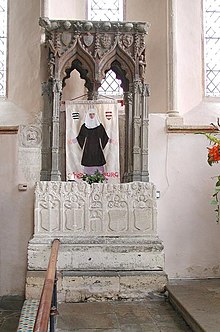
Eadburh was the daughter of King Edward the Elder of England and his third wife, Eadgifu of Kent. She lived most of her life as a nun known for her singing ability. Most of the information about her comes from hagiographies written several centuries after her life. She was canonised twelve years after her death and there are a small number of churches dedicated to her, most of which are located near Worcestershire, where she lived.
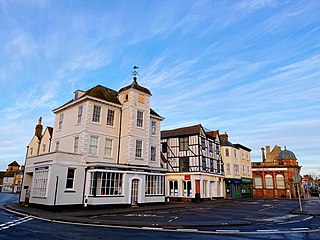
Bicester is a historical market town, garden town, and civil parish in the Cherwell district of northeastern Oxfordshire in south-central England that also comprises an eco town development at North West Bicester and a self-build village at Graven Hill. Its local market continues to thrive and is now located on Sheep Street, a very wide pedestrian zone in the conservation area of the town. Bicester is also known for Bicester Village, a nearby shopping centre.
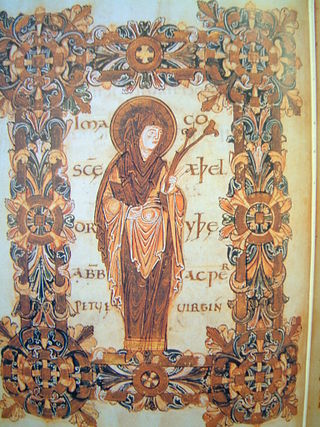
Æthelthryth was an East Anglian princess, a Fenland and Northumbrian queen and Abbess of Ely. She is an Anglo-Saxon saint, and is also known as Etheldreda or Audrey, especially in religious contexts. She was a daughter of Anna, King of East Anglia, and her siblings were Wendreda and Seaxburh of Ely, both of whom eventually retired from secular life and founded abbeys.
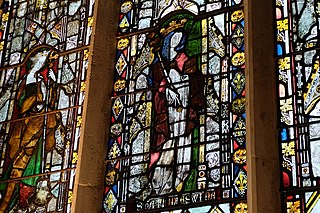
Frithuswith, commonly Frideswide, was an English princess and abbess. She is credited as the foundress of a monastery later incorporated into Christ Church, Oxford. She was the daughter of a sub-king of a Mercia named Dida of Eynsham whose lands occupied western Oxfordshire and the upper reaches of the River Thames.
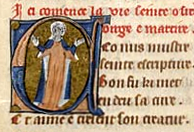
Osgyth was a Mercian noblewoman and prioress, venerated as an English saint since the 8th century, from soon after her death. She is primarily commemorated in the village of St Osyth, in Essex, near Colchester. Alternative spellings of her name include Sythe, Othith and Ositha. Born of a noble family, she became a nun and founded a priory near Chich which was later named after her.

Wilton Abbey was a Benedictine convent in Wiltshire, England, three miles west of Salisbury, probably on the site now occupied by Wilton House. It was active from the early tenth century until 1539.

Edith of Wilton was an English saint, nun and member of the community at Wilton Abbey, and the daughter of Edgar, King of England and Saint Wulfthryth. Edith's parents might have been married and Edgar might have abducted Wulfthryth from Wilton Abbey, but when Edith was an infant, Wulfthryth returned with Edith and their marriage was dissolved. Edith and her mother remained at Wilton for the rest of their lives.
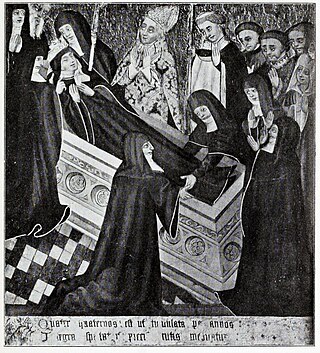
Seaxburh, also Saint Sexburga of Ely, was a Queen as well as an abbess, and is a saint of the Christian Church. She was married to King Eorcenberht of Kent.

Saint Mildrith, also Mildthryth, Mildryth and Mildred,, was a 7th- and 8th-century Anglo-Saxon abbess of the Abbey at Minster-in-Thanet, Kent. She was declared a saint after her death, and, in 1030, her remains were moved to Canterbury.
Saint Edburga of Minster-in-Thanet was a princess of Wessex, and abbess of Minster-in-Thanet. She is regarded as a saint.
Saint Edith of Polesworth is an obscure Anglo-Saxon abbess associated with Polesworth (Warwickshire) and Tamworth (Staffordshire) in Mercia. Her historical identity and floruit are uncertain. Some late sources make her a daughter of King Edward the Elder, while other sources claim she is the daughter of Egbert of Wessex. Her feast day is 15 July.
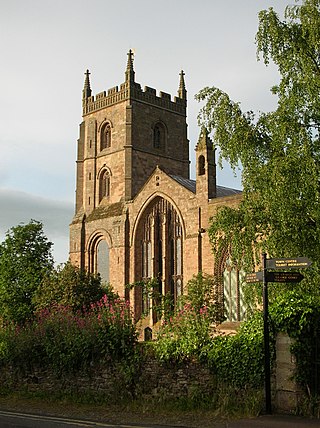
Leominster abbey was an Anglo-Saxon monastery established at Leominster in the county of Hereford, England. The name of the town refers to its minster, a settlement of clergy living a communal life.
St. Mary's Abbey, also known as the Nunnaminster, was a Benedictine nunnery in Winchester, Hampshire, England. It was founded between 899 and 902 by Alfred the Great's widow Ealhswith, who was described as the 'builder' of the Nunnaminster in the New Minster Liber Vitae. The first buildings were completed by their son, Edward the Elder. Among the house's early members was Edward's daughter Edburga.

The Church of St Aldhelm and St Eadburgha in Broadway, Somerset, England dates from the 13th century, and has been designated by English Heritage as a grade I listed building.
Saint Eanswith, also spelled Eanswythe or Eanswide, was an Anglo-Saxon princess, who is said to have founded Folkestone Priory, one of the first Christian monastic communities for women in Britain. Her possible remains were the subject of research, published in 2020.

Domne Eafe, also Domneva, Domne Éue, Æbbe, Ebba, was, according to the Kentish royal legend, a granddaughter of King Eadbald of Kent and the foundress of the double monastery of Minster in Thanet Priory at Minster-in-Thanet during the reign of her cousin King Ecgberht of Kent. A 1000-year-old confusion with her sister Eormenburg means she is often now known by that name. Married to Merewalh of Mercia, she had at least four children. When her two brothers, Æthelred and Æthelberht, were murdered she obtained the land in Thanet to build an abbey, from a repentant King Ecgberht. Her three daughters all went on to become abbesses and saints, the most famous of which, Mildrith, ended up with a shrine in St Augustine's Abbey, Canterbury.
Repton Abbey was an Anglo-Saxon Benedictine abbey in Derbyshire, England. Founded in the 7th century, the abbey was a double monastery, a community of both monks and nuns. The abbey is noted for its connections to various saints and Mercian royalty; two of the thirty-seven Mercian Kings were buried within the abbey's crypt. The abbey was abandoned in 873, when Repton was overrun by the invading Great Heathen Army.

Monks Kirby Priory was a Benedictine priory established in 1077 in Monks Kirby, Warwickshire, England. The priory was suppressed in 1415 when its estates and revenues were given to the Carthusian priory of Axholme in Lincolnshire, in whose possession they continued until the Reformation. Remains of the priory form part of Monks Kirby village church today.
Eadgyth of Aylesbury also known as Eadridus was a Dark Ages Catholic saint from Anglo-Saxon England.
Wulfthryth, also known as Wilfrida, was the second known consort of Edgar, King of England in the early 960s. Historians disagree whether she was his wife or mistress. Their daughter Edith was widely regarded in the eleventh century as a saint. In 964, Edgar married Ælfthryth, and then or earlier, Wulfthryth returned to Wilton Abbey, where she had been brought up, with her daughter. Wulfthryth remained there for the rest of her life as Abbess and died on 21 September in an unknown year, around 1000. She was regarded as a saint at Wilton, but her cult did not spread more widely.
